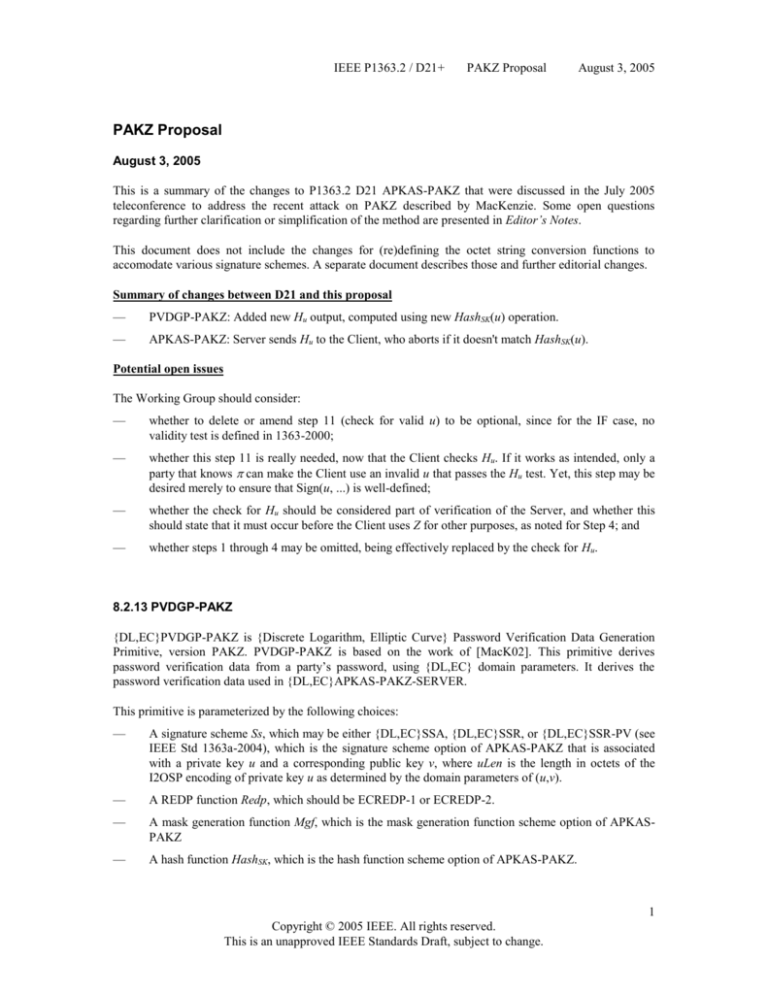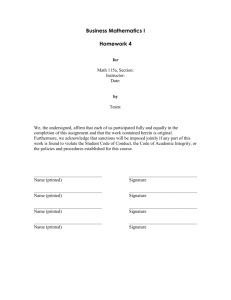
IEEE P1363.2 / D21+
PAKZ Proposal
August 3, 2005
PAKZ Proposal
August 3, 2005
This is a summary of the changes to P1363.2 D21 APKAS-PAKZ that were discussed in the July 2005
teleconference to address the recent attack on PAKZ described by MacKenzie. Some open questions
regarding further clarification or simplification of the method are presented in Editor’s Notes.
This document does not include the changes for (re)defining the octet string conversion functions to
accomodate various signature schemes. A separate document describes those and further editorial changes.
Summary of changes between D21 and this proposal
—
PVDGP-PAKZ: Added new Hu output, computed using new HashSK(u) operation.
—
APKAS-PAKZ: Server sends Hu to the Client, who aborts if it doesn't match HashSK(u).
Potential open issues
The Working Group should consider:
—
whether to delete or amend step 11 (check for valid u) to be optional, since for the IF case, no
validity test is defined in 1363-2000;
—
whether this step 11 is really needed, now that the Client checks Hu. If it works as intended, only a
party that knows can make the Client use an invalid u that passes the Hu test. Yet, this step may be
desired merely to ensure that Sign(u, ...) is well-defined;
—
whether the check for Hu should be considered part of verification of the Server, and whether this
should state that it must occur before the Client uses Z for other purposes, as noted for Step 4; and
—
whether steps 1 through 4 may be omitted, being effectively replaced by the check for Hu.
8.2.13 PVDGP-PAKZ
{DL,EC}PVDGP-PAKZ is {Discrete Logarithm, Elliptic Curve} Password Verification Data Generation
Primitive, version PAKZ. PVDGP-PAKZ is based on the work of [MacK02]. This primitive derives
password verification data from a party’s password, using {DL,EC} domain parameters. It derives the
password verification data used in {DL,EC}APKAS-PAKZ-SERVER.
This primitive is parameterized by the following choices:
—
A signature scheme Ss, which may be either {DL,EC}SSA, {DL,EC}SSR, or {DL,EC}SSR-PV (see
IEEE Std 1363a-2004), which is the signature scheme option of APKAS-PAKZ that is associated
with a private key u and a corresponding public key v, where uLen is the length in octets of the
I2OSP encoding of private key u as determined by the domain parameters of (u,v).
—
A REDP function Redp, which should be ECREDP-1 or ECREDP-2.
—
A mask generation function Mgf, which is the mask generation function scheme option of APKASPAKZ
—
A hash function HashSK, which is the hash function scheme option of APKAS-PAKZ.
1
Copyright © 2005 IEEE. All rights reserved.
This is an unapproved IEEE Standards Draft, subject to change.
IEEE P1363.2 / D21+
PAKZ Proposal
August 3, 2005
Input:
—
The password-based octet string
—
The {DL,EC} domain parameters associated with
Assumptions: Domain parameters are valid.
Output: The derived password verification data (m, v, ou, Hu), consisting of password-based mask group
element m, public key v for signature scheme Ss, octet string ou of length uLen containing the passwordmasked private key associated with v, and hashed private key octet string Hu (See Notes 2 and 3)
Operation: The password verification data shall be computed by the following or an equivalent sequence
of steps:
1.
2.
3.
4.
5.
6.
7.
8.
Compute password-mask group element m = Redp(hex(01) || ) (See Note 1)
Compute an octet string o1 = hex(02) ||
Compute a password-mask octet string o2 of length uLen as o2 = Mgf(o1, uLen)
Generate a key pair (u,v) for signature scheme Ss
Compute a private key octet string ou of length uLen using I2OSP(u)
Compute password-masked private key octet string ou = ou o2
Compute a hashed private key octet string Hu = HashSK(ou)
Output (m, v, ou, Hu) (See Note 2)
Conformance region recommendation: A conformance region should include limitations for any input
values as discussed in Annex B.
NOTES
1—Steps 2 through 8 of BPKAS-PAK key agreement operation are re-used in APKAS-PAKZ with the value of m as
computed here. The computation of m is different in BPKAS-PAK.
2—The output v could be public, but the other outputs must be kept hidden.
3—The APKAS-PAKZ server may want to store m^{1} to optimize efficiency.
9.7 APKAS-PAKZ
Editor's Note—The D21 description of APKAS-PAKZ was modified to exclude IF signature schemes due to two
inconsistencies in the D20 specification: (1) It refers to domain parameters associated with signature keys (u,v), which
are used in SIG2OSP-1 and OS2SIGP-1, but IF signature schemes have no domain parameters. (2) It uses private key u
as an integer, but IF private keys are tuples of two or more integers.
Editor's Note—This D21+ proposed version is based on the proposal by MacKenzie discussed in the July 20 2005
teleconference.
Editor's Note—The Working Group plans to discuss a problem in the proof of security found by Phil MacKenzie,
which may motivate a change in the protocol and/or further clarifying notes.
{DL,EC}APKAS-PAKZ-{CLIENT,SERVER} is {Discrete Logarithm, Elliptic Curve} Augmented
Password-Authenticated Key Agreement Scheme, version PAKZ for {Client, Server}. It is based on the
work of [MacK02].
2
Copyright © 2005 IEEE. All rights reserved.
This is an unapproved IEEE Standards Draft, subject to change.
IEEE P1363.2 / D21+
PAKZ Proposal
August 3, 2005
9.7.1 Scheme options
Both the Client and Server parties shall establish or otherwise agree upon the following options:
—
Primitives for password verification data generation, public key generation and secret value
derivation, which shall be PVDGP-PAKZ, PEPKGP-PAK, PKGP-DH, SVDP-PAK1-CLIENT and
SVDP-PAK2, and their associated parameters
—
A set of valid {DL,EC} domain parameters (including k, q, r, and g), associated with the values ,
m, u, v, ou, and v defined below
—
A signature scheme Ss associated with a private key u and corresponding public key v, which may be
either {DL,EC}SSA, {DL,EC}SSR, or {DL,EC}SSR-PV (see IEEE Std 1363a-2004), which
defines:
—
a signature generation operation Sign,
—
a signature verification operation Verify,
—
a Sig2osp conversion function that converts a signature to an octet string, which should be
SIG2OSP-1, and
—
an Os2sigp conversion function that converts an octet string to a signature, which should be
OS2SIGP-1, where
—
uLen is the length in octets of the I2OSP encoding of private key u and sLen is the length in
octets of the Sig2osp encoding of a signature produced by Sign, as determined by the domain
parameters of (u,v).
—
A mask generation function Mgf, which should be MGF1 (see 14.2.1). The same Mgf parameter
shall be used with {DL,EC}PVDGP-PAKZ.
—
A key derivation function Kdf, which should be KDF1 or KDF2
—
One or more key derivation parameter octet strings {P1, P2, ...} to be used to derive agreed keys
—
A key confirmation function, which should be KCF1
—
A hash function HashSK, which should be chosen from the hash functions in 14.1. The same HashSK
parameter shall be used with {DL,EC}PVDGP-PAKZ.
For CLIENT only:
—
A password-based octet string (See Note 4.)
For SERVER only:
—
Password verification data values that were derived from {DL,EC}PVDGP-PAKZ(), using the
Client’s values for and mask generation function Mgf, including:
— a password-based mask octet string m,
— the public key v associated with the signature scheme Ss, and
— an octet string ou of length uLen containing the password-masked value of the private key u that
corresponds to v.
— the hashed private key octet string Hu containing HashSK(ou).
3
Copyright © 2005 IEEE. All rights reserved.
This is an unapproved IEEE Standards Draft, subject to change.
IEEE P1363.2 / D21+
PAKZ Proposal
August 3, 2005
9.7.2 Key agreement operation
A sequence of shared secret keys, K1, K2, ... Kt, shall be generated by each party by performing the
following or an equivalent sequence of steps:
1.
2.
For CLIENT only:
1.1 Compute a mask group element m using Step 1 of {DL,EC}PVDGP-PAKZ( )
Perform the Key agreement operation Steps 2 through 8 as specified for {DL,EC}BPKASPAK-{CLIENT,SERVER} in Subclause 9.2.2 to derive keys K1, K2, ... Kt
NOTE—The Client shall confirm the Server’s knowledge of shared secret Z before any derived keys are used. Key
confirmation for APKAS-PAKZ is described in 9.7.3.
3.
Output derived keys K1, K2, ... Kt
9.7.3 Key confirmation operation
It is mandatory in APKAS-PAKZ for the Client to confirm the Server’s knowledge of the shared secret Z,
before the Client uses Z or any derived shared secrets Ki for other purposes. It is also mandatory for the
Server to confirm the Client’s knowledge of , as this provides the augmented advantage of APKAS-PAKZ
over BPKAS-PAK.
Key confirmation may be achieved using the following or an equivalent sequence of steps:
9.7.3.1 Key confirmation for Client
(Mandatory) The Client verifies that the Server's knows the verification data corresponding to as follows:
1.
2.
3.
4.
Receive octet string oS from the Server
Compute o = GE2OSP-X(m)
Compute o3 = KCF1(hex(03), wC, wS, Z, o)
If o3 oS, output “invalid” and stop.
Note—Step 4 must be performed before the Client uses Z or any derived shared secrets Ki for other purposes.
(Mandatory) The Client proves knowledge of to the Server as follows:
5.
Receive octet string AS, a hidden and password-masked private signature key, and hashed
private key octet string Hu from the Server
6. Compute o7 = KCF1(hex(05), wC, wS, Z, o)
7. Compute o5 = Mgf(o7, uLen)
8. Compute ou = AS o5 Mgf(hex(02) || , uLen)
9. If HashSK(ou) ≠ Hu, output “invalid” and stop.
10. Compute u = OS2IP(ou)
11. If u is not a valid private key for the Sign operation, output “invalid” and stop.
Editor's Note—Consider deleting or amending step 11 (check for valid u) to be optional, since for the IF case, no
validity test is defined in 1363-2000. Also consider whether this step is needed, now that the Client checks Hu. If it
works as intended, only a party that knows can make the Client use an invalid u that passes the Hu test. Yet, this step
may be desired merely to ensure that Sign(u, ...) is well-defined.
Editor's Note—Consider whether the check for Hu should be considered part of verification of the Server, and whether
this should state that it must occur before the Client uses Z for other purposes, as noted for Step 4.
4
Copyright © 2005 IEEE. All rights reserved.
This is an unapproved IEEE Standards Draft, subject to change.
IEEE P1363.2 / D21+
PAKZ Proposal
August 3, 2005
Editor's Note—Consider whether steps 1 through 4 may be omitted, being effectively replaced by the check for Hu.
12.
13.
14.
15.
16.
17.
Compute s = Sign(u, wS)
Compute S1 = Sig2osp(s)
Compute o8 = KCF1(hex(06), wC, wS, Z, o)
Compute o6 = Mgf(o8, sLen)
Compute SC = S1 o6
Send SC to the server
9.7.3.2 Key confirmation for Server
(Mandatory) The Server proves to the Client knowledge of the verification data corresponding to as
follows:
1.
2.
3.
Compute o = GE2OSP-X(m)
Compute oS = KCF1(hex(03), wC, wS, Z, o)
Send oS to the Client
(Mandatory) The Server verifies that the Client's knows as follows:
4.
5.
6.
7.
Compute o7 = KCF1(hex(05), wC, wS, Z, o)
Compute o5 = Mgf(o7, uLen)
Compute AS = ou o5
Send AS and Hu to the Client
8.
9.
10.
11.
12.
13.
Receive octet string SC from the Client
Compute o8 = KCF1(hex(06), wC, wS, Z, o)
Compute o6 = Mgf(o8, sLen)
Compute S1 = SC o6
Compute s = Os2sigp(S1)
If Verify(v, s) = “invalid”, output “invalid” and stop.
Conformance region recommendation: A conformance region should include limitations for any input
values as discussed in Annex B.
NOTES
1—APKAS-PAKZ is a unilateral commitment scheme, where the Server does not provide a commitment to the
password during the key agreement operations. In either the scheme or the invoking application protocol, the Client
must verify the Server’s proof of knowledge of the password-based value m before revealing any information derived
from the output derived keys. See D.5.4.9 for discussion of the limitations on the use of unilateral commitment
schemes in application protocols.
2—In this scheme, the test for a valid {DL,EC} password-entangled public key is the same as the test for a {DL,EC}
public key. That is, a public key w is presumed valid if it specifies an element of order r in the group defined by the
{DL,EC} domain parameters.
3—The steps for the Server to verify the Client's key are mandatory because they are needed to achieve the augmented
benefit of APKAS-PAKZ.
4—The APKAS-PAKZ server may want to store m^{1} to optimize efficiency.
5
Copyright © 2005 IEEE. All rights reserved.
This is an unapproved IEEE Standards Draft, subject to change.





